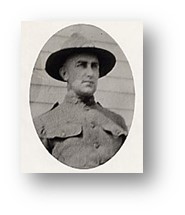Name: Furey, John Joseph, PVT, USA
Local address: 33 Gerard Avenue, Matawan Township, NJ
John, born March 20, 1892 in Matawan Township, was the second child and first son of Irish immigrants James P. Furey (1859-1933) and Clara Higgins (1864-1935), who married May 16, 1886 in Keyport. There were other Fureys in the area at that time who may be related. Father James worked various labor jobs over the years, starting with the railroad and then a local brickyard – at the time of his death he worked for the New York and Long Branch Railroad. The family subsequently had three more boys, James, Thomas and William.
Nothing is known of John’s early upbringing or schooling. When he registered for the draft on June 5, 1917, the record indicated he was a “towerman” for the railroad that employed his father. He was described as “tall” in height, medium build with blue eyes and brown hair.
He was drafted into the army on September 20, 1917 and departed for training at Camp Dix. Assigned to Company “D” of the 37th Division’s 148th Infantry Regiment, he departed for Europe on June 22, 1918 out of Newport News, VA aboard the SS Susquehanna.
His unit was involved in the Meuse-Argonne Offensive, part of the final Allied offensive of World War I. It helped bring an end to the war and was fought from September 26 – November 11, 1918, when the Armistice was signed.
Per the Division’s history, The Meuse-Argonne Offensive was the largest operation of the American Expeditionary Forces (AEF) in World War I, with over a million American soldiers participating. It was also the deadliest campaign in American history, resulting in over 26,000 soldiers being killed in action (KIA) and over 120,000 total casualties -the number of graves in the American military cemetery at Romagne is far larger than those in the more commonly known site at Omaha Beach in Normandy.
The 37th Division initiated the attack outside the French village of Avocourt, advancing directly into the Montfauquon forest, with the 91st and 79th Divisions striking on the flanks. Somewhere in this forest John was killed on September 28, 1918.
His body was initially buried in the above cemetery but was disinterred and returned to the US on July 25, 1921 aboard the SS Catigny with the remains of 1198 other serviceman. Received by the Bedle Funeral Home, John’s funeral was held at St. Joseph’s Church in Keyport, and his remains are buried there.
John’s younger brother James was drafted the same day as John but remained at Camp Dix as a sergeant involved in training. His younger brother William was a Matawan Township police officer who died of kidney failure in 1937 at 37 years of age.
The Ancient Order of Hibernians donated a stained-glass memorial window in John’s honor to the St. Joseph Church in August of 1919.


NO COMMENTS